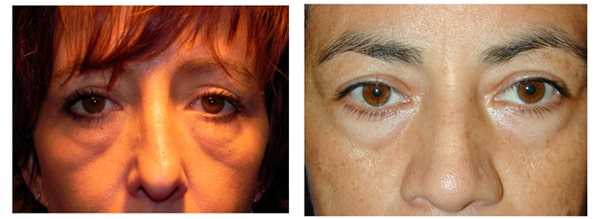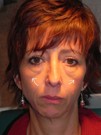What Is the Difference?
Many people who undergo lower eyelid surgery to improve the appearance of their lower lids are dissatisfied afterwards because of one factor which can complicate the results from lower eyelid surgery.
One factor which can complicate the results from lower eyelid surgery is lower eyelid/cheek festoons and malar mounds.
Festoons are a medical condition in which the skin of the lower eyelid becomes significantly damaged, usually by the sun. This damaged skin can result in folds in the lower eyelids and can lead to swollen mounds on the cheeks. They often occur with age and are more common in people with lighter skin types.
Festoons occur in many people seeking lower eyelid rejuvenation and if not corrected at the time that lower lid surgery is performed, the condition can become exacerbated and make the lower eyelids look worse after surgery.
Take a look at this patient before her surgery.
She has both lower eyelid bags and festoons as demonstrated in the next two photos. The festoons are not obvious here because the front flash of the camera is washing out the shadow below them. I have outlined them for you.
These two conditions can also be seen in the photo of another patient of mine prior to surgery. The white arrows point to the festoons, and I think you can now see the lower lid bag in the lower lid above the festoon.
The reason then why many people are dissatisfied after undergoing lower eyelid surgery to improve the appearance of their lower lids is the result of two main issues:
- Swelling that occurs in the face after lower eyelid surgery often accumulates in the lower eyelid region and can take a while to resolve.
- The subconscious brain constantly looks for balance in a face, and when lower eyelid fullness and festoons exist they are seen to belong together, as both are usually age-related phenomena. When only one is then corrected (usually the lower eyelid bags), the other is seen in even greater contrast. The subconscious brain then focuses in on this condition and tells the conscious brain the face is out of balance.
You can see this result in the case of this patient the day after surgery, where the bags were removed first and the festoons weren’t treated until one day later. This is her picture one day after surgery, and you will notice how much worse the festoons appear in a case like this when they not corrected at the same time the lower eyelid bags are corrected. The festoons are even more noticeable now than in the photos above taken before surgery.
Below are the patient’s photos before and after, correcting both the lower eyelid bags and festoons.
Effective Treatment for Festoons and Malar Mounds
Festoons and malar mounds have been a frustration for surgeons for many years. Thanks to the initial work of Dr. Sterling Baker (a person with whom I trained) and my own improvement and refinement on that work over the last decade, I now have a sophisticated, technically-challenging but effective treatment for festoons and malar mounds.
Many people, including some great surgeons, don’t fully understand or recognize the differences between these two conditions. I hope this blog article helps those reading to better understand those distinctions. The first difference is in their cause or etiology; festoons are a result of sun-damaged skin on the lower eyelid and on the cheek and are believed to be affected by underlying contrasting muscle forces over the years of a person’s life.
In contrast, lower eyelid bags are due to age-related fat protruding through the skin in the lower eyelid region. New research has shown that fat can grow and atrophy during our lives in asymmetric ways. The growth of fat in the orbit around the eye along with atrophy of fat in the facial regions around the eye, as well as weakness in some of the orbital containing structures, contribute the fullness we see in the lower eyelid with age.
For some individuals, this fat shows up at a very young age and this is believed to a result of genetic changes in the development of the eye area in those individuals.
The second difference is the location on the face where they form. Lower eyelid festoons can be seen primarily on the cheek with some presence in the lower eyelid region. Lower eyelid bags are located directly below the lower eyelid lashes and are noticed to become more prominent when someone with these bags looks upwards. Conversely, festoons are minimally affected when a person looks upwards.
The third difference is the feel of these conditions when they are touched. Festoons are squishy and can be made to move side to side. Lower eyelid bags are firmer, deeper in location beneath the skin and can’t be moved easily side to side when touched.
It is important to understand the differences between these two conditions. The best rejuvenation and most natural results occur when both eyelid bags and festoons are corrected simultaneously.
For more information on cosmetic eyelid rejuvenation, festoons, request an appointment.







